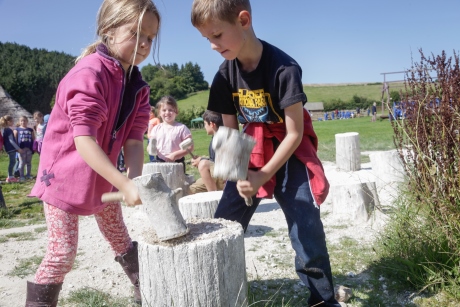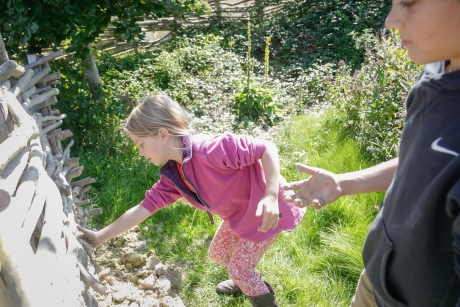
Students chalk bashing at Butser Ancient Farm.
Itinerary: Iron Age to Roman
Provider: Butser Ancient Farm, near Petersfield, Hampshire
Subjects: History, English, Art and Design Technology
Key Stage: 2
Nestled in the South Downs National Park, Butser Ancient Farm is an experimental archaeology site which specialises in school visits, with topics from within Stone Age, Bronze Age, Iron Age, Roman and Saxon eras.
Over 15 practical activities complement the National Curriculum, and the following itinerary is a typical day for Key Stage 2, concentrating on Iron Age to Roman.
10:00am: Arrive and be met by the education officer. After signing in, a change of shoes and toilet visit, everyone will receive a short safety talk. Walk down to the farm, via the ancient breeds of goats and sheep.
10:30am: Introductory talk inside one of the ancient houses, where children will see the fire alight in the middle of the room. This provides the opportunity to compare the way ancient people lived to today, and for children to ask questions. Prepare for hands-on activities, with groups of more than 30 being divided into smaller parties.
11:00am: Have a go at ‘clunching’ and discover how Iron Age people made their walls. Starting with chalk bashing, then mixing the resulting powder with soil and water, everyone gets their hands dirty. Once the mixture has reached the right level of stickiness, pupils apply it to the clunch building.

Clunching at Butser Ancient Farm.
11:30am: In an archaeology session pupils learn how to use a trowel and see what they can uncover. They learn what is special about the items they ‘unearth’, and why other objects didn’t survive.
12:15pm: Time for a packed lunch, which can be eaten in one of the ancient homes or on a grassy area, giving children a chance to run around. Warm blackcurrant squash can be provided at 50p per cup if pre-ordered, and the shop serves a range of hot drinks for teachers.
12:45pm: Tour the Roman villa and compare it to the Iron Age roundhouses. Pupils then design a mosaic pattern using tiles, and teachers can take photos of the work for use back in the classroom.
1:15pm: The final activity involves pupils making a piece of jewellery to take home.
1:45pm: Visit to the shop where items are grouped by time period, making it easier for the children to select something relating to their topic. They are also encouraged to use Maths to add up how much they have spent and work out if any change is needed.
2:00pm: A quick goodbye summary and Q&A session with the education team where children are asked if they would have liked to live in an ancient house and whether they would want to have been a Roman or a Celt. Timings can be flexible throughout the day to fit around preferred arrival and departure times.
For more information call 02392-598838 or visit www.butserancientfarm.co.uk.










